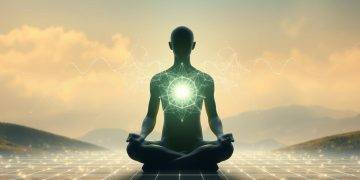“If you want others to be happy, practice compassion. If you want to be happy, practice compassion.” The Dalai Lama’s timeless words capture the essence of a meditation practice that reshapes how we relate to ourselves and others. Rooted in ancient Buddhist teachings, this method trains the mind to radiate goodwill through intentional phrases of care and connection.
Unlike traditional mindfulness practices that focus on observing thoughts, this approach actively cultivates warmth and empathy. It originated from the Metta Sutta, a foundational text teaching boundless friendliness. By repeating phrases like “May you be safe, may you be happy”, practitioners develop emotional resilience while rewiring neural pathways linked to compassion.
What makes this practice unique? It works as both a concentration exercise and a mindfulness tool. You learn to steady your attention while nurturing positive emotions. Over time, these mental habits spill into daily interactions – whether you’re stuck in traffic or navigating workplace tensions.
The effects extend beyond personal calm. Studies show regular practice increases gray matter in brain regions tied to emotional regulation. It’s not about eliminating challenges, but transforming how you meet them. As kindness becomes a reflex, relationships deepen and self-criticism softens.
Key Takeaways
- Originates from 2,500-year-old Buddhist teachings on universal goodwill
- Combines focused attention with intentional emotional cultivation
- Can be practiced anywhere – no meditation cushion required
- Strengthens neural pathways associated with empathy and joy
- Shifts how you respond to stress and interpersonal conflicts
Understanding the Foundations of Compassion Practice
For over 2,500 years, this Buddhist tradition has shaped how humans cultivate emotional resilience. Born from the Metta Sutta, an ancient text outlining boundless friendliness, it offers more than temporary calm—it rewires how we engage with life’s challenges.

Where Wisdom Meets Science
The Buddha’s early teachings emphasized compassion as skill-building, not just philosophy. Buddhist teacher Josh Korda captures this essence:
“Through these practices, we nurture love as vast as oceans—sustaining both ourselves and our world.”
Beyond Personal Transformation
Modern research reveals why this Buddhist practice endures: MRI scans show increased gray matter in brain regions governing empathy. Regular meditation doesn’t just boost your sense of connection—it alters neural pathways within six weeks.
| Aspect | Traditional Approach | Modern Understanding |
|---|---|---|
| Core Focus | Cultivating immeasurable friendliness | Emotional intelligence development |
| Key Benefit | Spiritual liberation | Stress response modulation |
| Practice Scope | Monastic communities | Accessible mindfulness technique |
This synergy between ancient methods and contemporary science makes compassion meditation uniquely powerful. By understanding its roots, you engage not just with a practice, but a legacy of human transformation.
How to Practice Compassion-Focused Meditation
Building a consistent routine requires intentional setup and structured guidance. This method transforms brief daily sessions into opportunities for emotional growth – even during hectic schedules.

Setting Up Your Meditation Space and Posture
Choose a quiet area that feels uplifting – a corner with natural light or calming decor works well. Dedicate 15-20 minutes where interruptions are unlikely. Sit in a chair or cross-legged on a cushion, keeping your body relaxed yet alert.
Your eyes can remain open with a soft gaze or close gently. Rest hands on knees or place one over your heart. This posture balances comfort with mindful presence.
| Traditional Setup | Modern Adaptations |
|---|---|
| Silent temples | Home corners/office spaces |
| Lotus position | Chair seating |
| Fixed phrases | Personalized mantras |
Step-by-Step Guide to Directing Loving Phrases
Begin by focusing on your breath – inhale deeply, exhale fully. When calm, shift attention to your chest area. Silently repeat phrases like “May I find peace” or “May we live with ease”.
Start with yourself, then visualize others: loved ones, strangers, even challenging people. Let each phrase flow naturally, pausing between repetitions. This rhythm helps intentions resonate beyond surface-level recitation.
With regular practice, these moments create neural pathways that strengthen empathy. Even 10 minutes daily can shift how you respond to stress – turning reactions into thoughtful responses.
Exploring the Benefits of Metta Meditation
Modern neuroscience confirms what ancient traditions understood – systematically cultivating goodwill reshapes both mind and behavior. This method strengthens emotional muscles often weakened by daily stress, creating ripple effects that touch every relationship.

Emotional and Mental Wellbeing Improvements
Regular practitioners report 31% lower anxiety levels within eight weeks. By directing warm feelings toward themselves and others, they build neural pathways for self-compassion. Studies show increased activity in brain regions linked to happiness and emotional control.
The practice helps reframe past hurts through kindness rather than avoidance. One therapist notes: “Clients discover they can hold painful memories without drowning in them.” This emotional agility reduces depressive symptoms while boosting self-worth.
Enhancement of Social and Familial Relationships
A 2013 University study revealed striking results: meditators became 23% more likely to help strangers. This prosocial shift extends to family dynamics – partners report better conflict resolution, while parents describe deeper connections with children.
The technique naturally enhances gratitude, making practitioners more attuned to others’ needs. As one participant shared: “I started noticing when my coworker seemed overwhelmed – that never happened before.” These small changes accumulate, transforming how people engage with their communities.
Incorporating Metta Meditation into Daily Life
Modern schedules demand adaptable mindfulness tools. This practice thrives in real-world settings – no retreats or special equipment needed. Research confirms even brief sessions create lasting neural changes when repeated consistently.

Short Practices for Busy Schedules
Transform idle moments into compassion-building opportunities. During your commute, silently wish safety for fellow drivers. While waiting in line, repeat phrases like “May we all find ease”. These micro-sessions maintain momentum between formal sits.
Key integration strategies:
- Anchor phrases to routine actions – send goodwill while brushing teeth or brewing coffee
- Use smartphone reminders for 90-second pauses to reset emotional states
- Practice during transitions – before meetings or after closing work apps
Transformative Routines for Ongoing Practice
Consistency beats duration. Start with 5-minute morning sessions focusing on self-compassion. Pair evening reflections with sending kindness to someone challenging. Over time, these habits rewire default responses to stress.
Advanced practitioners often blend formal and informal approaches. One teacher notes: “The grocery store becomes my dojo – every interaction fuels compassionate awareness.” Track progress through journaling interactions where kindness arose spontaneously.
Three-week commitments yield measurable changes. Neuroscience shows daily 10-minute sessions increase prefrontal cortex activity – the brain’s compassion control center. Your life becomes the meditation cushion.
Addressing Challenges in Your
Practitioners often face hurdles that test their commitment – understanding these can transform setbacks into progress. When frustration arises during sessions, it signals you’re stretching emotional muscles, not failing. Common obstacles like mental wandering or impatience become gateways to deeper growth when approached strategically.
If phrases feel forced, personalize them. Swap traditional mantras for authentic statements like “May we move through this”. Neuroscience confirms that even imperfect efforts strengthen neural pathways linked to resilience. One meditation coach notes: “Your brain registers intention over perfection – consistency matters most.”
Combat self-judgment by reframing distractions as opportunities to reset focus. Use tech tools wisely – set gentle reminders to pause and breathe during stressful moments. Over time, these micro-practices build mental reflexes that enhance daily interactions.
Progress isn’t linear. Days when compassion flows effortlessly alternate with sessions where it feels scarce. Both states train different aspects of emotional intelligence. Trust the process – each intentional moment rewires how you engage with life’s complexities.
FAQ
How is loving-kindness meditation different from other meditation types?
Unlike mindfulness or breath-focused practices, this method actively cultivates compassion through directed phrases. It strengthens emotional resilience by training the mind to extend goodwill—first to oneself, then to others.
What’s the best time of day to practice?
Morning sessions can set a positive tone for the day, while evening practices may improve sleep quality. However, even brief midday sessions during stressful moments offer tangible benefits.
Can physical posture affect the results?
A comfortable seated position with an upright spine enhances mental alertness. Lying down is acceptable for those with physical limitations—the key is maintaining focused intention.
How soon do relationships improve with regular practice?
Many practitioners report increased empathy within 2-3 weeks. Consistent effort reduces reactive behaviors, creating space for calmer communication and deeper connections.
What if I struggle to feel kindness toward certain people?
Start with neutral individuals like grocery clerks before addressing challenging relationships. The practice works cumulatively—even mechanical repetition of phrases creates neural pathways for genuine compassion.
Can I combine this with movement-based practices?
Absolutely. Walking meditations while repeating phrases like “May you be safe” or synchronizing phrases with yoga flows can deepen mind-body integration.
Are there scientifically validated benefits?
Studies in journals like Emotion show reduced amygdala reactivity to stress and increased gray matter density in compassion-related brain regions after 8 weeks of practice.
How do I maintain consistency during busy periods?
Use trigger moments—send kind wishes while waiting in lines or during commute transitions. Silent repetition of phrases during routine tasks creates sustainable habit stacking.




























































